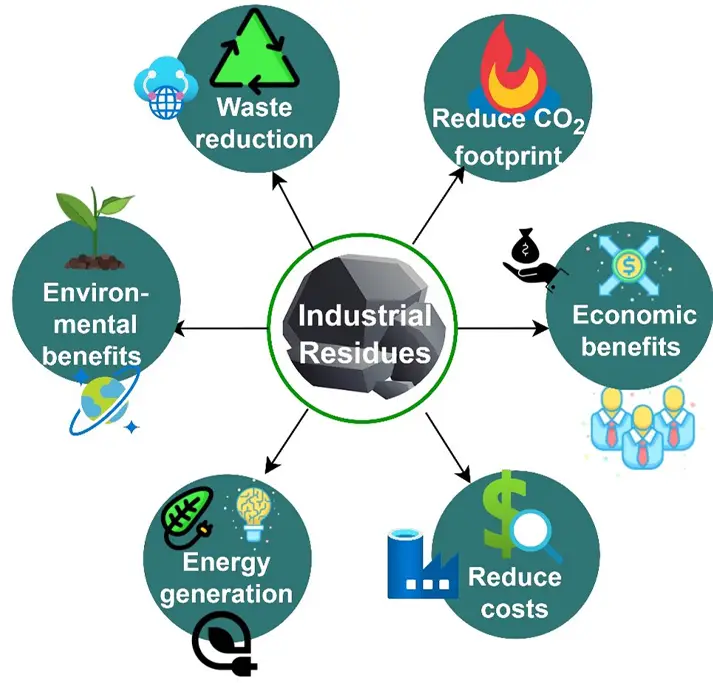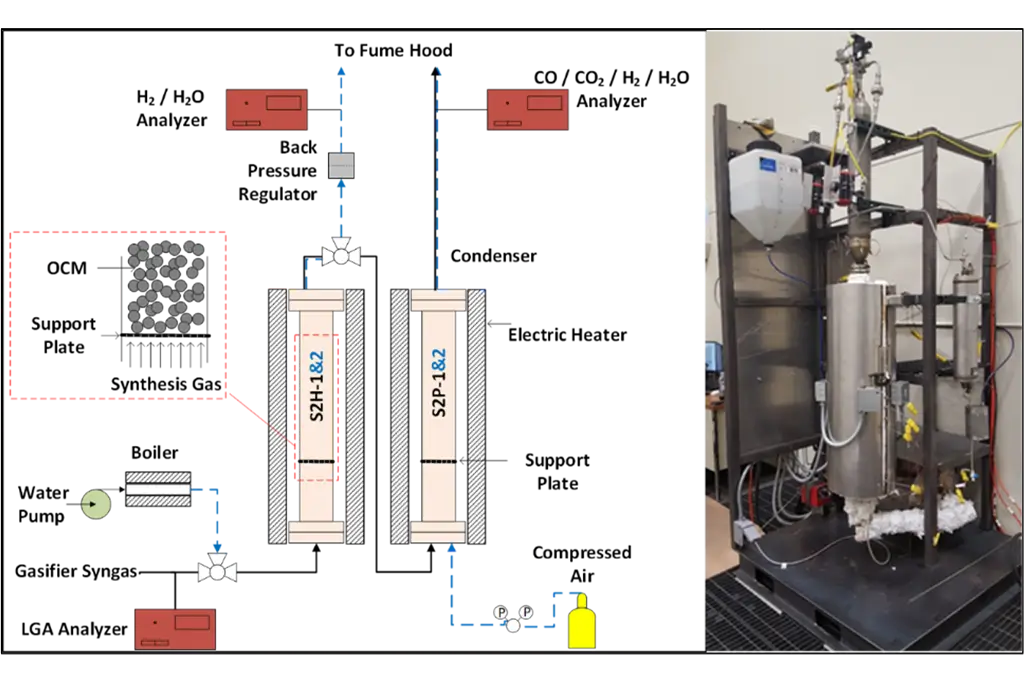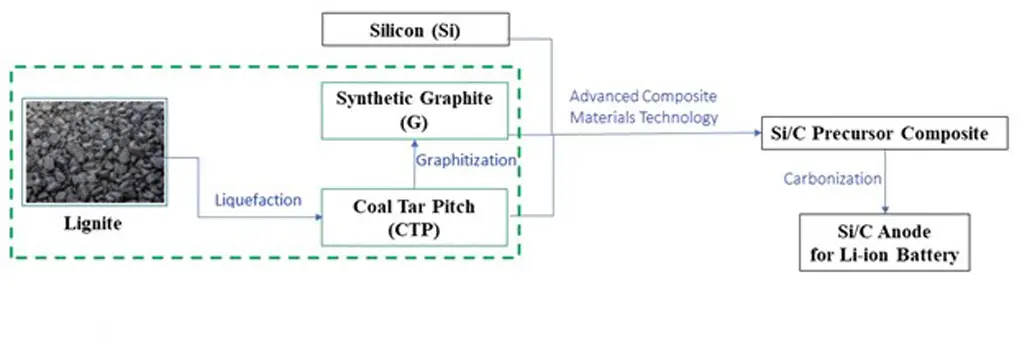Featured Projects
The CPER team has been working on carbon management technology development since 2008 and is involved in a wide range research and development efforts being supported by the Department of Energy, the State of North Dakota, and industry and small business partners. Areas of expertise and interest within this broad research area include:
- Carbon capture, utilization and storage (CCUS), including point sources and direct air capture
- Carbon dioxide mineralization
- Advanced power generation systems (e.g., chemical looping technologies and advanced power cycles)
- Low-carbon fuels (e.g., hydrogen, biomass, biofuels)
- Low/zero-emissions fossil fuel conversions (e.g. methane pyrolysis)
- Efficiency improvements for existing power generation and industrial facilities
- Flexible/co-generation technologies
- Other emerging technologies to reduce the carbon footprint of the energy industry
Featured Projects
CO2 Mineralization of Industrial Wastes
The CPER team is embarking on a collaborative project titled “Resource Assessment of Industrial Wastes for CO2 Mineralization” in partnership with Envergex LLC. The project has received a total funding amount of $1,250,000, with $1,000,000 granted by the Department of Energy and $250,000 provided by the North Dakota Industrial Commission.
In this project, we are exploring the potential of using industrial residues for CO2 sequestration via mineralization. Materials under investigation include:
- cement kiln dust
- coal ash
- sulfur scrubber residues
- biomass processing residues
- recycled concrete residues
- iron and steel slag
- copper slag
These industrial residues, often causing environmental concerns, have significant potential for capturing and storing millions of tons of CO2 close to CO2 emission sources. The research team will conduct detailed chemical and physical characterization of these residues and perform laboratory-scale tests to determine their CO2 storage capacity and economic value after CO2 mineralization.
Contact

- johannes.vanderwatt@UND.edu
- 701.777.5177
-
Collaborative Energy Complex Room 246C
Grand Forks ND 58202-8153
Biomass-based Hydrogen Production
CPER, in partnership with Envergex LLC, Singularity Energy Technologies, and the North Dakota Industrial Commission – Renewable Energy Program, is demonstrating a novel process-intensified and modular Combined Hydrogen Heat and Power (CH2P) production technology. Our process technology integrates a novel adaptation of the steam-iron process to produce high purity hydrogen from gasification of biomass and biomass blends with a compression-ready carbon dioxide (CO2) stream, enabling significant progress towards DOE's Hydrogen Shot cost of H2 goal of $1/kg of clean H2.
A key pathway towards decarbonization of the energy and transportation sectors is development of clean H2 technologies with low to negative carbon intensity. Our CH2P process combines multiple innovative components that will advance the current state of the art for the steam-iron process, and expedite the commercial deployment. We identify multiple commercial applications that will de-risk deployment of the technology – power generation, heating, H2 and potentially ammonia.
Our flexible operation capability and suite of products offer a unique value proposition for rural areas with significant agricultural activities. Large farms, rural cooperatives and small municipalities will be a key target market. The total project funding is $2,120,000, with $1,600,000 awarded by the Department of Energy and the remainder by the State of North Dakota and private sector partners.
Contact

- nasah.domkam@UND.edu
- 701.777.4307
-
Collaborative Energy Complex Room 246F
Grand Forks ND 58202-8153
The CPER team has become a national leader in the development of technologies for unconventional and secondary resources/ores for critical minerals (CM) and rare earth elements (REEs) recovery and processing. In 2016, the team was among the first groups to win funding from the Department of Energy to evaluate coal and coal byproducts as an alternative source of REEs, with a proof-of-concept project focusing on North Dakota lignite coal and associated materials. That initial work has developed into a several million-dollar portfolio of projects and leading expertise across areas involving resource exploration/characterization and mineral processing technology development and evaluation.
MORE INFORMATION ON REE/CM AND CPER'S TECHNOLOGY COMMERCIALIZATION EFFORTS
Featured Projects
Pilot-Scale Demonstration of REE/CM from Lignite
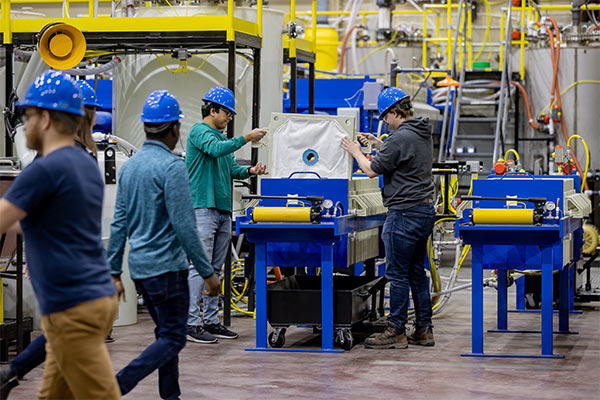
The CPER team is partnering with Microbeam Technologies Incorporated (MTI), Barr Engineering Co., and Rare Earth Salts Separation & Refining, LLC (RES) to demonstrate at a pilot-scale our novel technology for rare earth element (REE) recovery from North Dakota lignite coal and related feedstocks. The project will be conducted with funding from the Department of Energy and cost share support from the Lignite Research Program of the North Dakota Industrial Commission, North American Coal Corporation, Great River Energy, Minnkota Power Cooperative, BNI Energy, MTI and UND.
The project builds on several years of prior technology development at the lab and bench-scales and leverages the unique properties of lignite. North Dakota lignite coal has been discovered with REE levels as high as anything ever reported previously for U.S. coals. In lignite coal, the REE are weakly bound within the organic matter of the lignite, rather than in strong mineral forms that are typical of higher-rank coals. These organic associations permit simple dilute acid leaching. The technology is much less complex than most REE mineral processing methods, potentially offering significant cost savings. Finally, the leaching process is also a coal beneficiation process, offering value-added opportunities for the upgraded lignite byproduct. The total DOE funding is $5,394,255, with $1,764,300 provided by the State of ND and private sector partners, for a total project of $7,158,555.
Williston Basin CORE-CM
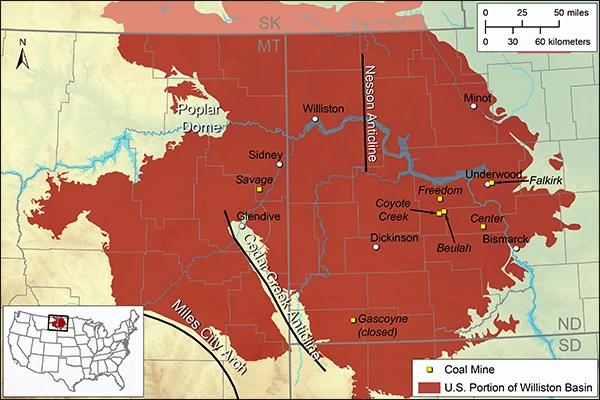
UND’s Energy & Environmental Research Center, in partnership with CPER and many other organizations, is leading a project to set the stage for future expansion and transformation of coal and coal-based resource utilization within the Williston Basin for the production of rare-earth elements (REEs), critical minerals (CMs), and nonfuel carbon-based products.
Contact

- nolan.theaker@UND.edu
- 701.777.6298
-
Collaborative Energy Complex Room 246C
Grand Forks ND 58202-8153
The CPER team specializes in the development of advanced battery chemistry's, with a particular focus on leveraging North Dakota’s unique natural resources in the development of high-performance and low-cost carbon products such as synthetic graphite. There is significant synergy between this work and the team’s work on critical minerals and rare earth elements, representing an opportunity to maximize the value across several product streams and downstream applications.
The team has leading expertise in materials development, battery fabrication and testing, and technology scale-up and evaluation. We are actively involved in several projects funded by the Department of Energy, State of North Dakota, and industry and small business partners, with multiple technologies being marketed for commercial implementation.
Areas of expertise and interest include:
- Lithium-ion batteries (anode & cathode materials development)
- Advanced battery chemistry's (Li-S, Na ion, etc.)
- Battery fabrication and testing (coin cell through 2-10 Ah pouch cells and 18650 cells)
- In-situ/operando characterization and battery management systems (fast-charging designs, pack thermal management, pack testing – 12kW, & modeling)
- Carbon-based products development for batteries (synthetic graphite, graphene, MCMBs)
Featured Projects
Silicon/Carbon Anode for Li-ion Batteries
Building on several years of experience with lignite coal chemistry and utilization and battery materials development, the CPER team is partnering with North American Coal Corporation and Clean Republic to demonstrate a novel technology to produce silicon-carbon composite battery anodes using abundant North Dakota lignite coal as a feedstock.
The overall goal of this project is to develop advanced anode materials for lithium ion batteries (LIB) from lignite-derived carbon feedstock. The anticipated benefits of this project are:
- the unique high-quality lignite-derived pitch and synthetic graphite will be suitable feedstocks for high-value carbon-based LIB anode materials such as Si–C composite anodes
- the current technology of preparing Si–C anode materials will be advanced toward a low-cost and high-performance product
- the project will accelerate the commercialization of production of high-quality lignite-derived pitch and synthetic graphite through opening a high-value LIB market
- the domestic and international marketability of U.S. coals and of domestic production of LIBs will be increased.
The total project funding is $667,000, with $500,000 from the Department of Energy and the remainder from the State of North Dakota and private sector partners.
Lignite Coal to Synthetic Graphite in North Dakota
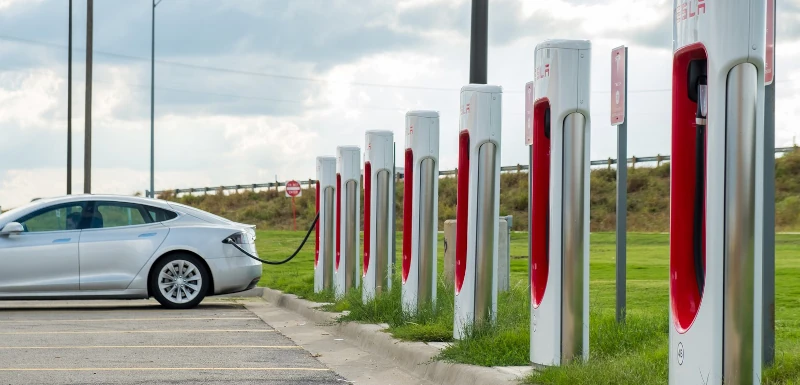
With funding from the North Dakota Industrial Commission, CPER, our partner AmeriCarbon, and other collaborators have initiated efforts to design, construct, and operate a commercial-scale carbon products manufacturing facility in McLean County, North Dakota (“McLean Plant”). The McLean Plant will use North Dakota lignite in AmeriCarbon’s patented and proprietary Liquid Carbon Pitch (LCP) process to manufacture Eco-Pitch™, a 100% domestic sourced alternative to coal tar pitch, a critical supply material for the production of synthetic graphite and other carbon materials.
The McLean Plant will be an important commercial-scale demonstration of the production of critical materials while creating sustainable employment in high tech manufacturing. The McLean Plant will provide full manufacturing capability with a capacity to produce 15,000 tons of primary products (Eco-Pitch™, asphalt binder and graphite) annually and an additional 13,500 tons of by-products, while demonstrating AmeriCarbon’s proprietary and commercially viable technology for future expansion and replication in additional coal impacted communities.
The CPER team and AmeriCarbon have developed a viable approach for commercial production
of battery grade graphite from lignite coal. Among various coal types, lignite
has demonstrated that it is reactive and adaptive to structural change upon chemical
processing, which is a critical step in graphite production. The AmeriCarbon/CPER
approach for graphite anode production provides a much better fast-charging capability,
which has been identified as a major roadblock to wide scale electric vehicle (EV)
deployment. The team’s approach will also result in a higher packing density and thereby
higher energy density. Various forms of graphite and/or carbon materials (pitch, needle coke, MCMBs) are
needed to specifically make spherical “battery grade graphite”. Success in this project
would represent the only demonstrated domestic graphite produced exclusively from
lignite-coal and enable the United States in reducing its dependence on off-shore
foreign suppliers for this critical strategic material.
Contact

- xiaodong.hou@UND.edu
- 701.777.6350
-
Leonard Hall Room 300
Grand Forks ND 58202-8153
